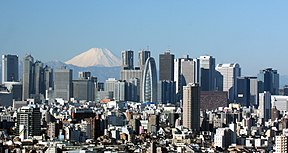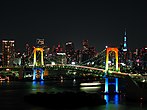
Tokyo
Capital and largest prefecture of Japan / From Wikipedia, the free encyclopedia
Dear Wikiwand AI, let's keep it short by simply answering these key questions:
Can you list the top facts and stats about Tokyo?
Summarize this article for a 10 years old
Tokyo (/ˈtoʊkioʊ/;[7] Japanese: 東京, Tōkyō, [toːkʲoː] ⓘ), officially the Tokyo Metropolis (東京都, Tōkyō-to), is the capital and the most populous prefecture of Japan.[8] Tokyo's metropolitan area (including neighboring prefectures as well as Tochigi, Gunma and Ibaraki; 13,452 square kilometers or 5,194 square miles) is the most populous in the world, with an estimated 37.468 million residents as of 2018[update];[9] although this number has been gradually decreasing since then, the prefecture itself has a population of 14.09 million people[4] while the prefecture's central 23 special wards have a population of 9.73 million.[10] Located at the head of Tokyo Bay, the prefecture forms part of the Kantō region on the central coast of Honshu, Japan's largest island. Tokyo serves as Japan's economic center and is the seat of both the Japanese government and the Emperor of Japan.
Tokyo
東京都 | |
|---|---|
| Tokyo Metropolis | |
| Anthem: "Tokyo Metropolitan Song" (東京都歌, Tōkyō-to Ka) | |
 Interactive map outlining Tokyo | |
 Location within Japan | |
| Coordinates: 35°41′23″N 139°41′32″E | |
| Country | Japan |
| Region | Kantō |
| Island | Honshu |
| Capital | Tokyo[1] |
| Divisions | 23 special wards, 26 cities, 1 district, and 4 subprefectures |
| Government | |
| • Body | Tokyo Metropolitan Government |
| • Governor | Yuriko Koike (Indp.) |
| • Representatives | 42 |
| • Councilors | 11 |
| Area | |
| • Total | 2,194.07 km2 (847.14 sq mi) |
| • Metro | 13,452 km2 (5,194 sq mi) |
| • Rank | 45th in Japan |
| Highest elevation | 2,017 m (6,617 ft) |
| Lowest elevation | 0 m (0 ft) |
| Population (2023)[4] | |
| • Total | 14,094,034 |
| • Rank | 1st in Japan |
| • Density | 6,363/km2 (16,480/sq mi) |
| • Urban | 39,105,000 |
| • Metro | 40,800,000 |
| • Metro density | 3,000/km2 (7,900/sq mi) |
| • Dialects | |
| Demonym | Tokyoite |
| Gross Regional Product (2018)[6] | |
| • Total, nominal | ¥107 trillion |
| • Per capita | ¥7.7 million |
| Time zone | UTC+09:00 (Japan Standard Time) |
| ISO 3166-2 | JP-13 |
| Flower | Yoshino cherry |
| Tree | Ginkgo |
| Bird | Black-headed gull |
| Website | tokyotokyo.jp www.metro.tokyo.lg.jp |
Originally a fishing village named Edo, the city emerged into political prominence in 1603, when it became the seat of the Tokugawa shogunate. By the mid-18th century, Edo was one of the most populous cities in the world with a population of over one million people. Following the Meiji Restoration of 1868, the imperial capital in Kyoto was moved to Edo, which was renamed "Tokyo" (lit. 'Eastern Capital'). Tokyo was devastated by the 1923 Great Kantō earthquake, and again by Allied bombing raids during World War II. Beginning in the 1950s, the prefecture underwent rapid reconstruction and expansion efforts, going on to lead the Japanese economic miracle. In 1968, Japan became the second largest economy, only behind the United States.[11] Since 1943, the Tokyo Metropolitan Government has administered the prefecture's special wards (formerly Tokyo City), various commuter towns and suburbs in its western area, and two outlying island chains known as the Tokyo Islands.
Tokyo is the largest urban economy in the world by gross domestic product, and is categorized as an Alpha+ city by the Globalization and World Cities Research Network. It is also Japan's leading business hub as part of an industrial region that includes the cities of Yokohama, Kawasaki, and Chiba. As of 2023[update], Tokyo is home to 29 companies of the Fortune Global 500.[12] In 2020, the city ranked fourth on the Global Financial Centres Index, behind only New York City, London, and Shanghai.[13] Tokyo is home to the world's tallest tower, Tokyo Skytree,[14] and the world's largest underground floodwater diversion facility, the Metropolitan Area Outer Underground Discharge Channel (located in Kasukabe, Saitama, a suburb of Tokyo).[15] The Tokyo Metro Ginza Line, opened in 1927, is the oldest underground metro line in East Asia.[16] Recognized as one of the most livable cities in the world, Tokyo was tied fourth with Wellington in the 2021 Global Livability Ranking.[17]
The city has hosted multiple international events, including the 1964 Summer Olympics and 1964 Summer Paralympics, the 2020 Summer Olympics and 2020 Summer Paralympics (postponed; held in 2021), and three summits of the G7 (in 1979, 1986, and 1993). Tokyo is an international research and development hub and is likewise represented by several major universities, most notably the University of Tokyo. Tokyo Station is the central hub for Japan's high-speed railway network, the Shinkansen; Shinjuku Station in Tokyo is also the world's busiest train station. Notable special wards of Tokyo include: Chiyoda, the site of the National Diet Building and the Tokyo Imperial Palace; Shinjuku, the city's administrative center; and Shibuya, a commercial, cultural, and business hub.

.jpg/78px-Tokyo_Skytree_at_night_(Iki).jpg)








